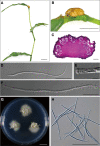Revision of the genus Aciculosporium (Clavicipitaceae) with a description of a new species on wavyleaf basketgrass, and proline-containing cyclic dipeptide production by A. take
- PMID: 37091325
- PMCID: PMC9157783
- DOI: 10.47371/mycosci.2021.01.002
Revision of the genus Aciculosporium (Clavicipitaceae) with a description of a new species on wavyleaf basketgrass, and proline-containing cyclic dipeptide production by A. take
Abstract
The genus Aciculosporium (Clavicipitaceae, Hypocreales, Ascomycota)was established in 1908 for A. take , which is the causal fungus of witches' broom of bamboo. Although the original description was valid at that time, a type specimen for A. take has not been designated. To standardize the use of this genus and species name, a neotypification and reference specimen of A. take are proposed. Multilocus phylogenetic analyses based on DNA sequences from 28S rDNA, TEF, Tub2, Mcm7, and RPB2 revealed that A.sasicola is from a different lineage to A. take, and other specimens from wavyleaf basket grass (Oplismenus undulatifolius) represent a distinct species proposed here as Aciculosporium oplismeni sp. nov. Chemical analysis using mass spectrometry and nuclear magnetic resonance spectroscopy showed that A. take produces four proline-containing cyclic dipeptides, which are moieties of ergot alkaloids. However, ergot alkaloids, lolines, peramine, indole-diterpenes, and lolitrem were not detected in the culture solvent. This study offers clarification of the lineage and morphology of this genus.
Keywords: Aciculosporium oplismeni; Claviceps; Ergot alkaloids; Hypocreales; Witches' broom.
2021, by The Mycological Society of Japan.
Figures




Similar articles
-
In search of lost ergots: phylogenetic re-evaluation of Claviceps species in Japan and their biogeographic patterns revealed.Stud Mycol. 2023 Nov;106:1-39. doi: 10.3114/sim.2023.106.01. Epub 2023 Jul 17. Stud Mycol. 2023. PMID: 38298573 Free PMC article.
-
Specific in situ visualization of the pathogenic endophytic fungus Aciculosporium take, the cause of witches' broom in bamboo.Appl Environ Microbiol. 2009 Jul;75(14):4829-34. doi: 10.1128/AEM.00635-09. Epub 2009 May 22. Appl Environ Microbiol. 2009. PMID: 19465522 Free PMC article.
-
Mechanisms of bamboo witches' broom symptom development caused by endophytic/epiphytic fungi.Plant Signal Behav. 2010 Apr;5(4):415-8. doi: 10.4161/psb.5.4.10834. Epub 2010 Apr 2. Plant Signal Behav. 2010. PMID: 20118669 Free PMC article.
-
Lolitrem B and Indole Diterpene Alkaloids Produced by Endophytic Fungi of the Genus Epichloë and Their Toxic Effects in Livestock.Toxins (Basel). 2016 Feb 15;8(2):47. doi: 10.3390/toxins8020047. Toxins (Basel). 2016. PMID: 26891327 Free PMC article. Review.
-
Ergot Alkaloids of the Family Clavicipitaceae.Phytopathology. 2017 May;107(5):504-518. doi: 10.1094/PHYTO-12-16-0435-RVW. Epub 2017 Mar 29. Phytopathology. 2017. PMID: 28168931 Free PMC article. Review.
Cited by
-
Henon bamboo flowering recorded first time in 120 years revealed how Aciculosporium take affects the floral organs of the host.Mycoscience. 2024 Aug 9;65(5):228-234. doi: 10.47371/mycosci.2024.06.001. eCollection 2024. Mycoscience. 2024. PMID: 39720017 Free PMC article.
-
Antifungal Metabolites as Food Bio-Preservative: Innovation, Outlook, and Challenges.Metabolites. 2021 Dec 23;12(1):12. doi: 10.3390/metabo12010012. Metabolites. 2021. PMID: 35050134 Free PMC article. Review.
-
Morphological and phylogenetic characterisation of two new soil-borne fungal taxa belonging to Clavicipitaceae (Hypocreales, Ascomycota).MycoKeys. 2023 Jun 7;98:113-132. doi: 10.3897/mycokeys.98.106240. eCollection 2023. MycoKeys. 2023. PMID: 37324546 Free PMC article.
-
In search of lost ergots: phylogenetic re-evaluation of Claviceps species in Japan and their biogeographic patterns revealed.Stud Mycol. 2023 Nov;106:1-39. doi: 10.3114/sim.2023.106.01. Epub 2023 Jul 17. Stud Mycol. 2023. PMID: 38298573 Free PMC article.
References
-
- Carrieri, R., Borriello, G., Piccirillo, G., Lahoz, E., Sorrentino, R., Cermola, M., Censi, S., Grauso, L., Mangoni, A., & Vinale, F. (. 2020). Antibiotic Activity of a Paraphaeosphaeria sporulosa-Produced Diketopiperazine against Salmonella enterica. Journal of Fungi, 6, 1- 9. https://doi.org/10.3390/jof6020083. - PMC - PubMed
-
- Chanclud, E. & Morel, J. (2016). Plant hormones: a fungal point of view. Molecular Plant Pathology, 17, 1289-1297. https://doi.org/10.1111/mpp.12393. - PMC - PubMed
-
- Ehmann, A. (1977). The van URK-Salkowski reagent — a sensitive and specific chromogenic reagent for silica gel thin-layer chromatographic detection and identification of indole derivatives. Journal of Chromatography A, 132, 267-276. https://doi.org/10.1016/S0021-9673(00)89300-0 - PubMed
-
- Fdhila, F., Vázquez, V., Sánchez, J. L., Riguera, R., (2003). DD-Diketopiperazines: Antibiotics active against Vibrio anguillarum isolated from marine bacteria associated with cultures of Pecten maximus. Journal of Natural Products, 66, 1299-1301. https://doi.org/10.1021/np030233e. - PubMed
-
- Hara, K. (1908). On witches' broom disease of bamboo(in Japnanese). Gifuken Nokai Zasshi 20, 13-14.
LinkOut - more resources
Full Text Sources
